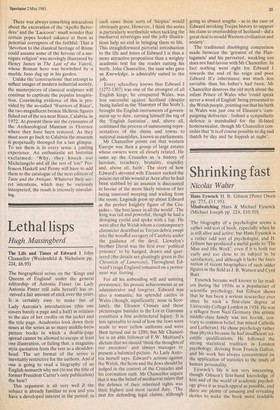Master pieces
Harold Acton
Taste and the Antique: The Lure of Classical Sculpture 1500-1900 Francis Haskell and Nicholas Penny (Yale University Press pp. 376, £20) The centennial resurrection and apotheosis followed by the fall from favour of classical sculpture in Europe are the dominant themes of Taste and the Antique, designed by its authors as 'a contribution to the history of taste'. Far from being a mere contribution this is an encyclopaedic work for whose genial scholarship we were prepared by Professor Haskell's Patrons and Painters and Professor Penny's Church Monuments in Romantic England.
About 50 years ago the fall from favour was noted by Roger Fry as 'a striking instance of the reversals of generally accepted judgments'. Now Professors Haskell and Penny are blazing the trail for a fresh reversal in this enthralling study, nowledged masterpieces with over 90 chapters and a historical catalogue of acknowledged masterpirces with over 90 illustrations. Photographs of sculpture are seldom satisfactory: only those with dark backgrounds suggest the curves of Venuses and muscles of Apollos in marble and bronze, but as aids to memory the illustrations are adequate.
In a period when mechanical gadgets and the refuse of rubbish heaps –absurd concoctions from 'found materials' – are pretentiously exhibited as sculptures even in Venice, it is exhilarating to be reminded of the masterpieces of classical antiquity, regardless of whether they have reached us as copies or reconstructions of long-lost originals in Greece.
'Many of these statues which have received the votive offerings of generations of conoscenti', wrote the supercilious Fry, 'are now relegated to remote corridors or fulfil a more humble and appropriate service as little noticed garden ornaments'. Appropriate certainly, but are they indeed so humble and little noticed? Those generations of conoscenti so brilliantly evoked in these pages were sometimes mistaken in their attributions but they were not philistines. Copies of classical statues by Coysevox and Soldani were by no means contemptible, and discriminating readers of Taste and the Antique will examine them with renewed interest and appreciation.
As the most enlightened popes and emperors realised, sculptures are seen to best advantage in the open air: you must move around them to appreciate their plastic values. Indoors they are difficult to place except in galleries and entrance halls of ample dimensions when they are apt to make a monotonous impression and lose their individuality. Few modern tourists have enjoyed a classical education, consequently they miss the full significance of what confronts them in crowded sculpture galleries. Familiar with Plutarch and Ovid and Lempriere, the leisurely 'grand tourists' of the 17th and 18th centuries were able to inspect them with a friendly eye The importance of plaster-casts in promoting appreciation of the most esteemed and coveted of antique statues cannot be over-emphasised, and Francois I was the most prominent of pioneer collectors outside Italy when he commissioned them from Primaticcio for Fontainebleau. Apart from providing a criterion of aesthetic judg ment, Frangois 'enjoyed exploiting the titillating effects of the nudity of the statues on the ladies of his court'. Louis XIV and Napoleon were to follow his good example, the latter with spectacular ruthlessness.
With the mass production of plaster-casts in the 19th century bronze and marble copies began to suffer from the new technology when 'sand-casting replaced the lost-wax method'. Hence, as the authors sadly explain in the last chapter, 'many more dull and downright bad bronze copies after the antique were produced in the 19th than in previous centuries'. The proliferation of such unworthy copies was chiefly responsible for the fall from favour reported by Roger Fry. They should not be confused with the exquisite reproductions by a Giambologna. Had I not been privileged by juvenile contact with masterpieces of classical sculp ture, I too might have become prejudiced by the schoolroom plaster-casts whose very texture made one grit one's teeth like chalk on a blackboard. Only the most vivid imagination could detect the Hellenic spirit in those lifeless lustreless shapes with squalid associations. There was always something miraculous about the excavation of the 'Apollo Belvedere' and the `Laocoon': small wonder that certain popes looked askance at them as potential corrupters of the faithful. That a 'devotion to the classical heritage of Rome could assume some of the fervour of a surrogate religion' was movingly illustrated by Henry James in The Last of the Valerii, whose Roman hero was bewitched by a marble Juno dug up in his garden.
Unlike the 'constructions' that attempt to reflect images of modern industrial society, the masterpieces of classical sculpture will continue to captivate the popular imagination. Convincing evidence of this is provided by the so-called 'Warriors of Riace, the two magnificent bronze Hellenic figures fished out of the sea near Riace, Calabria, in 1972. At present these are the cynosures of the Archaeological Museum in Florence where they have been restored. As they must soon go back to Calabria the museum is perpetually thronged for a last glimpse. To see them is in every sense a jostling experience. An enthusiastic art historian exclaimed: 'Why, they knock out Michelangelo and all the rest of 'em!' Professors Haskell and Penny will have to add them to the catalogue of the next edition of Taste and the Antique. Whatever their secret intentions, which may be variously interpreted, the result is intensely stimulating.



















































































 Previous page
Previous page